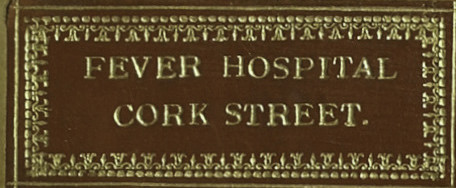The 1830’s brought a new set of problems to the city and to the hospital.
1831 3170
1832 3602
1833 3991
1834 3332
1835 4524
1836 4672
1837 5565
1838 6595
1839 4042
1840 5958
The total number admitted in this period was 45,451. The first serious outbreak of cholera occurred and the hospital found itself involved in a public controversy over its attitude to cholera patients. In Dr Stoker’s 1835 review he commenced by examining the cholera epidemic of 1832. The extent or limits of medical knowledge is revealed in his attempts to understand the origins of the epidemic. He was of the opinion that ‘east and northeast winds blowing from an extensive strand and viciual soil during the time of neap tides’ added to the extent of the problem. This affected people living on the lee shore many of whom were predisposed by ‘want of necessary support or by despondence from the miserable state of trade.’ The first outbreak that year, occurred during Lent, and he believed that fasting contributed to the problem. He also stated that from his conversations with Roman Catholic and Protestant clergymen, the fever was confined entirely to members of the Catholic faith.
https://archive.org/details/sketchofmedicals00stok/page/n7
In 1831 there had been a trickle of cholera cases treated in the hospital but by 1832 the city was experiencing, what was then the worst epidemic of the century. In Dublin alone cholera affected 11,000 with the death rate put at 5273. (The Dublin Medical Press, (Dublin , July 1st 1846) p141 ) A large number of the dead were buried in Bully’s Acre graveyard in Kilmainham and as a consequence the graveyard was obliged to close due to its overcrowded condition. Cholera had spread across Europe through the shipping ports. It reached Quebec where its origins were attributed to an Irish emigrant ship.(George Fenwick, (ed) Canada Medical Journal, (Montreal 1869) p3 ) Cork Street Fever Hospital refused to treat the victims of cholera, during this epidemic, believing it to be so infectious as to threaten the lives of other patients. The board actually obliged Dr. Stoker to retire for ignoring this rule despite his thirty two years of service there. Other Dublin hospitals also refused on
the same grounds. A public meeting of medical officers was held in the coffee room of the Royal Exchange to demand that cholera patients be treated in fever hospitals. Various proposals including one demanding a posse of police to force hospitals to admit cholera patients were put. This meeting referred to the ingratitude of Cork Street for their outrageous treatment of Dr Stoker. In the event cholera patients were treated in Grangegorman hospital which was referred to as the Dublin Cholera Hospital.about 1600 victims of the outbreak were buried in Grangegorman. In 1875 work on the extension of the Midland Great Western Railway resulted in their remains being relocated to nearby channels. During the extension of the Luas works which is scheduled to open in 2017 these remains were again discovered. Their final resting place is under discussion.
Like the AIDS epidemic of the twentieth century the source of the infection was much discussed. Was it a new virus or a more severe version of cholera which had been seen before in Dublin? Its origin was traced to Asia and it became known as Asiatic cholera where it had been prevalent for some years. Like typhus however its spread was caused by the same conditions, poor sanitation. In 1836 cholera again took hold and Grangegorman hospital was once again used as the treatment centre. At the latter end of the 1830’s another epidemic affected the city and it was so serious that tents were once again needed to cater for the number of patients. Writing in the annual report of 1837 Dr. Kennedy attributes the problem to an outbreak of influenza and an outbreak of typhus fever. In all Dublin hospitals 11,085 had been admitted suffering from fever with more than half admitted to the Cork Street hospital. Living conditions were still a major issue with Kennedy mentioning that physicians have never seen conditions so bad with ten to twenty people living in small rooms. As was often the case the fever chiefly affected the poorer classes. Unusually it seriously affected the staff at the hospital. Every physician was attacked by fever and two of them died. Every nurse was affected with one death reported. The annual report states that many of the nursing staff had been unscathed by previous epidemics. The decision to use tents was an administrative one based on medical need but as Kennedy points out, the death rate in June in the tents was one in seven while in the hospital it was one in fifteen. Kennedy diplomatically observes that those in the tents were more exposed to atmospheric changes and influences than those in the house. Once again in this annual report there is extensive data on the weather conditions with daily reports for 1837. Opium is mentioned as a treatment for patients suffering from typhus and delirium tremens. It was administered in powder form and described as Dover’s powder. Kennedy was of the opinion that there was no drug that requires more observation than the use of opium in the treatment of fever. Wine however was still preferred with an average quantity of eight ounces over twenty four hours being the recommended dose. (Annual Reports 1837-1838) The 1840’s were the period when famine again stalked the land. Unfortunately neither annual report nor minute book survive for the critical years 1847 to 1850.Though the numbers admitted were less than in the previous decade 33,801 as against 45,451 the nature of the various outbreaks appears to be more serious. The latter part of the decade is notable for the eye witness accounts of the extent of disease and crowded hospitals.
